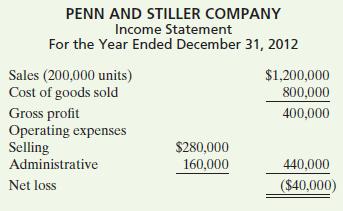The condensed income statement for the Penn and Stiller partnership for 2012 is as follows. A cost
Question:
The condensed income statement for the Penn and Stiller partnership for 2012 is as follows.

A cost behavior analysis indicates that 75% of the cost of goods sold are variable, 50% of the selling expenses are variable, and 25% of the administrative expenses are variable.
Instructions
(Round to nearest unit, dollar, and percentage, where necessary. Use the CVP income statement format in computing profits.)
(a) Compute the break-even point in total sales dollars and in units for 2012.
(b) Penn has proposed a plan to get the partnership “out of the red” and improve its profitability. She feels that the quality of the product could be substantially improved by spending $0.25 more per unit on better raw materials. The selling price per unit could be increased to only $6.25 because of competitive pressures. Penn estimates that sales volume will increase by 30%. What effect would Penn’s plan have on the profits and the break-even point in dollars of the partnership (Round the contribution margin ratio to two decimal places.)
(c) Stiller was a marketing major in college. She believes that sales volume can be increased only by intensive advertising and promotional campaigns. She therefore proposed the following plan as an alternative to Penn’s. (1) Increase variable selling expenses to $0.79 per unit, (2) lower the selling price per unit by $0.30, and (3) increase fixed selling expenses by $35,000. Stiller quoted an old marketing research report that said that sales volume would increase by 60% if these changes were made. What effect would Stiller’s plan have on the profits and the break-even point in dollars of the partnership?
(d) Which plan should be accepted? Explain your answer.
Step by Step Answer:

Accounting Principles
ISBN: 978-0470534793
10th Edition
Authors: Jerry J. Weygandt, Paul D. Kimmel, Donald E. Kieso





